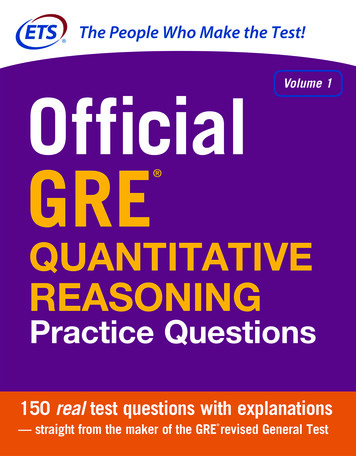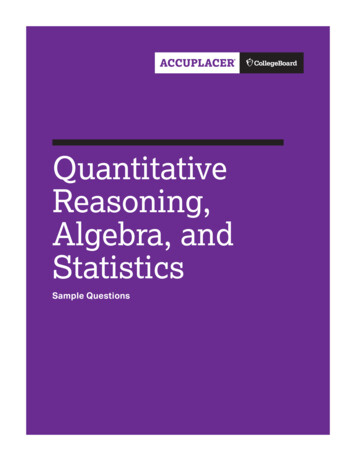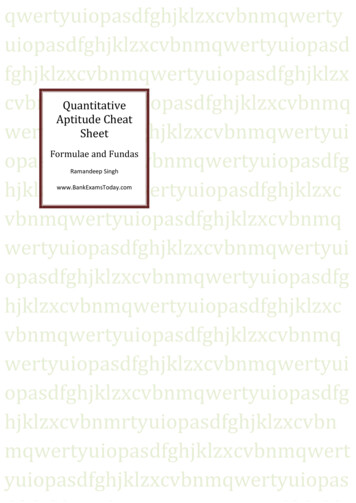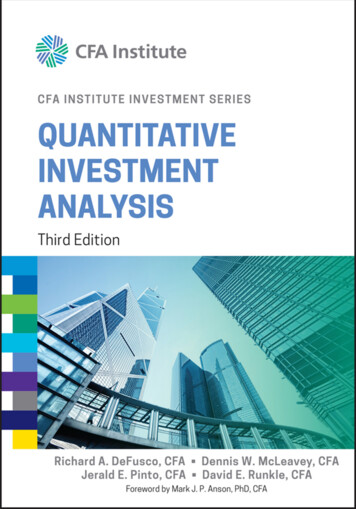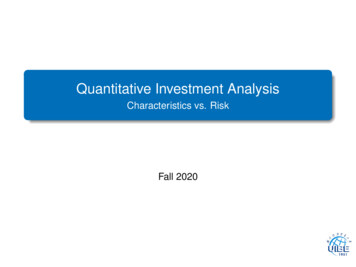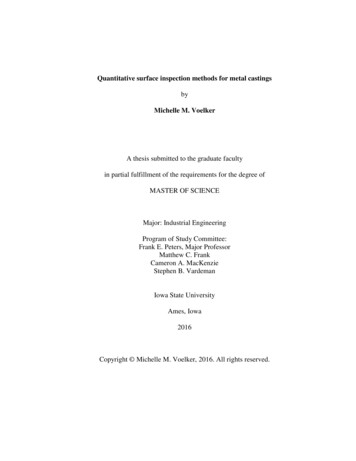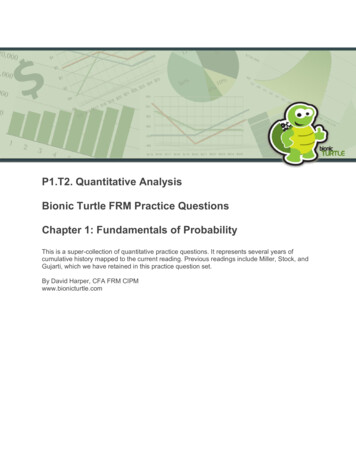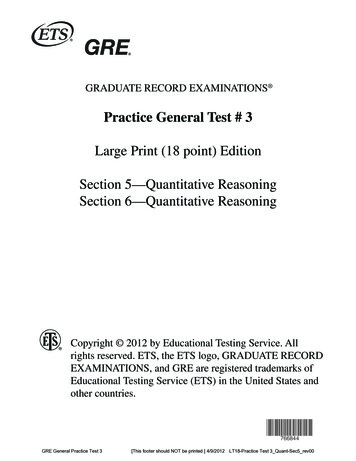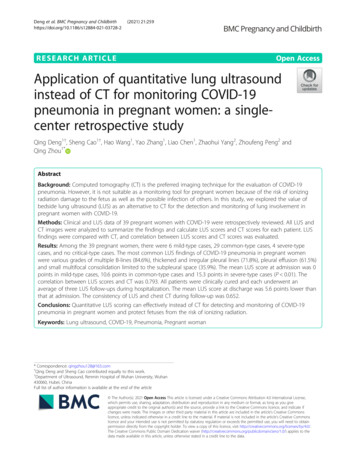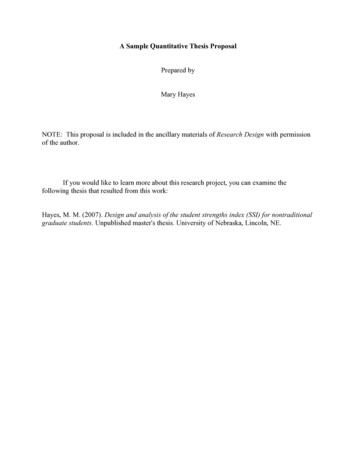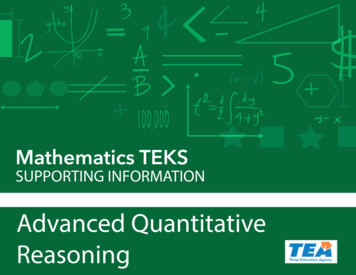
Transcription
SUPPORTING INFORMATIONAdvanced QuantitativeReasoningTexas Education Agency
The materials are copyrighted (c) and trademarked (tm) as the property of the Texas Education Agency (TEA) and may not be reproduced without theexpress written permission of TEA, except under the following conditions: Texas public school districts, charter schools, and Education Service Centers may reproduce and use copies of the Materials and RelatedMaterials for the districts’ and schools’ educational use without obtaining permission from TEA. Residents of the state of Texas may reproduce and use copies of the Materials and Related Materials for individual personal use only withoutobtaining written permission of TEA. Any portion reproduced must be reproduced in its entirety and remain unedited, unaltered and unchanged in any way. No monetary charge can be made for the reproduced materials or any document containing them; however, a reasonable charge tocover only the cost of reproduction and distribution may be charged.Private entities or persons located in Texas that are not Texas public school districts, Texas Education Service Centers, or Texas charter schools or anyentity, whether public or private, educational or non-educational, located outside the state of Texas MUST obtain written approval from TEA and will berequired to enter into a license agreement that may involve the payment of a licensing fee or a royalty.For information contact:Office of Copyrights, Trademarks, License Agreements, and Royalties,Texas Education Agency,1701 N. Congress Ave., Austin, TX 78701-1494;phone: 512-463-9041email: copyrights@tea.texas.gov 2016 Texas Education Agency. All Rights Reserved 2016 2015 Texas Education Agency. All Rights Reserved 2015Mathematics TEKS: Supporting InformationUpdated September 2017
Advanced Quantitative Reasoning - MathematicsTEKSSupporting Information(a) General requirements.Students shall be awarded one-half to one credit for successful completion of this course.Prerequisites: Geometry and Algebra II.The TEKS include descriptions of prerequisite coursework.(b) Introduction.(1) The desire to achieve educational excellence is the driving force behind the Texasessential knowledge and skills for mathematics, guided by the college and career readinessstandards. By embedding statistics, probability, and finance, while focusing on fluency andsolid understanding, Texas will lead the way in mathematics education and prepare all Texasstudents for the challenges they will face in the 21st century.(b) Introduction.(2) The process standards describe ways in which students are expected to engage in thecontent. The placement of the process standards at the beginning of the knowledge andskills listed for each grade and course is intentional. The process standards weave the otherknowledge and skills together so that students may be successful problem solvers and usemathematics efficiently and effectively in daily life. The process standards are integrated atevery grade level and course. When possible, students will apply mathematics to problemsarising in everyday life, society, and the workplace. Students will use a problem-solvingmodel that incorporates analyzing given information, formulating a plan or strategy,determining a solution, justifying the solution, and evaluating the problem-solving processand the reasonableness of the solution. Students will select appropriate tools such as realobjects, manipulatives, paper and pencil, and technology and techniques such as mentalmath, estimation, and number sense to solve problems. Students will effectivelycommunicate mathematical ideas, reasoning, and their implications using multiplerepresentations such as symbols, diagrams, graphs, and language. Students will usemathematical relationships to generate solutions and make connections and predictions.Students will analyze mathematical relationships to connect and communicate mathematicalideas. Students will display, explain, or justify mathematical ideas and arguments usingprecise mathematical language in written or oral communication.(b) Introduction.(3) In Advanced Quantitative Reasoning, students will develop and apply skills necessary forcollege, careers, and life. Course content consists primarily of applications of high schoolmathematics concepts to prepare students to become well-educated and highly informed21st century citizens. Students will develop and apply reasoning, planning, andcommunication to make decisions and solve problems in applied situations involvingnumerical reasoning, probability, statistical analysis, finance, mathematical selection, andmodeling with algebra, geometry, trigonometry, and discrete mathematics.(b) Introduction.(4) Statements that contain the word "including" reference content that must be mastered,while those containing the phrase "such as" are intended as possible illustrative examples.Geometry and Algebra II are required prerequisites.A well-balanced mathematics curriculum includes the Texas College and Career ReadinessStandards.A focus on mathematical fluency and solid understanding allows for rich exploration of the key ideasin Advanced Quantitative Reasoning.This paragraph occurs second in the TEKS, preceding the content descriptions. This highlights theemphasis of student use of the mathematical process standards to acquire and demonstratemathematical understanding.The concept of generalization and abstraction in the text from AQR(1)(B) included in theintroductory paragraphs from elementary TEKS may be considered subsumed in this language.Computer programs in the text from AQR(1)(C) may be included under technology.This introductory paragraph states, “Students will use mathematical relationships to generatesolutions and make connections and predictions,” instead of the text from AQR(1)(E).Specifics about Advanced Quantitative Reasoning mathematics content is summarized in thisparagraph. This summary follows the paragraph about the mathematical process standards. Thissupports the notion that the TEKS should be learned in a way that integrates the mathematicalprocess standards in an effort to develop fluency. The paragraph also connects the key conceptsfound in Advanced Quantitative Reasoning to prior content and the Texas College and CareerReadiness Standards.The State Board of Education approved the retention of some “such as” statements within the TEKSwhere needed for clarification of content.The phrases “including” and “such as” should not be considered as limiting factors for the studentexpectations (SEs) in which they reside.Additional Resources are available online includingVertical Alignment ChartsTexas Mathematics Resource PageTexas College and Career Readiness Standards 2015 Texas Education Agency. All Rights Reserved 2015Mathematics TEKS: Supporting InformationUpdated September 20171
Advanced Quantitative Reasoning - MathematicsTEKS: Mathematical Process Standards.Supporting InformationAQR(1)(A) Mathematical process standards. The student uses mathematical processes toacquire and demonstrate mathematical understanding.The student is expected to apply mathematics to problems arising in everyday life,society, and the workplace.AQR(1)(B) Mathematical process standards. The student uses mathematical processes toacquire and demonstrate mathematical understanding.The student is expected to use a problem-solving model that incorporates analyzinggiven information, formulating a plan or strategy, determining a solution, justifying thesolution, and evaluating the problem-solving process and the reasonableness of thesolution.AQR(1)(C) Mathematical process standards. The student uses mathematical processes toacquire and demonstrate mathematical understanding.The student is expected to select tools, including real objects, manipulatives, paper andpencil, and technology as appropriate, and techniques, including mental math,estimation, and number sense as appropriate, to solve problems.AQR(1)(D) Mathematical process standards. The student uses mathematical processes toacquire and demonstrate mathematical understanding.The student is expected to communicate mathematical ideas, reasoning, and theirimplications using multiple representations, including symbols, diagrams, graphs, andlanguage as appropriate.AQR(1)(E) Mathematical process standards. The student uses mathematical processes toacquire and demonstrate mathematical understanding.The student is expected to create and use representations to organize, record, andcommunicate mathematical ideas.AQR(1)(F) Mathematical process standards. The student uses mathematical processes toacquire and demonstrate mathematical understanding.The student is expected to analyze mathematical relationships to connect andcommunicate mathematical ideas.AQR(1)(G) Mathematical process standards. The student uses mathematical processes toacquire and demonstrate mathematical understanding.The student is expected to display, explain, and justify mathematical ideas andarguments using precise mathematical language in written or oral communication. 2015 Texas Education Agency. All Rights Reserved 2015This SE emphasizes application. The opportunities for application have been consolidated intothree areas: everyday life, society, and the workplace.This SE, when paired with a content SE, allows for increased relevance through connections withinand outside mathematics. Example: When paired with AQR(2)(D), students may be expected tosolve geometric problems such as those encountered when building a bridge, constructing askyscraper, or mapping planetary distances.This process standard applies the same problem-solving model and is included in the TEKS forkindergarten through grade 12.This is the traditional problem-solving process used in mathematics and science. Students may beexpected to use this process in a grade appropriate manner when solving problems that can beconsidered difficult relative to mathematical maturity.The phrase “as appropriate” indicates that students are assessing which tools and techniques toapply rather than trying only one or all of those listed. Example: When paired with AQR(3)(A), thestudent may be expected to estimate a prediction based upon the scatterplot or other model.Students may be expected to address three areas: mathematical ideas, reasoning, andimplications of these ideas and reasoning.Communication can be through the use of symbols, diagrams, graphs, or language. The phrase“as appropriate” implies that students may be expected to assess which communication tool toapply rather than trying only one or all of those listed.The use of multiple representations includes translating and making connections among therepresentations. Example: When paired with AQR(4)(R), students may justify the selectedpresentation format given the needs of a particular audience.The expectation is that students use representations for three purposes: to organize, record, andcommunicate mathematical ideas.Representations include verbal, graphical, tabular, and algebraic representations. As studentscreate and use representations, the students will evaluate the effectiveness of the representationsto ensure that those representations are communicating mathematical ideas with clarity.Example: When paired with AQR(4)(M), students may be expected to collect and organize datafrom a population of interest.Students may be expected to analyze relationships and form connections with mathematicalideas.Students may form conjectures about mathematical representations based on patterns or sets ofexamples and non-examples. Forming connections with mathematical ideas extends pastconjecturing to include verification through a deductive process. Example: When paired withAQR(3)(G), students may be expected to look for and analyze various models for expenditures todetermine a course of action.The expectation is that students speak and write with precise mathematical language to explainand justify the work. This includes justifying a solution. Example: When paired with AQR(4)(F),the student may be expected to explain in precise mathematical language why a given event canbe considered to be mathematically fair.Mathematics TEKS: Supporting InformationUpdated September 20172
Advanced Quantitative Reasoning - MathematicsTEKS: Numeric reasoning.Supporting InformationAQR(2)(A) Numeric reasoning. The student applies the process standards in mathematics togenerate new understandings by extending existing knowledge. The student generates newmathematical understandings through problems involving numerical data that arise in everydaylife, society, and the workplace. The student extends existing knowledge and skills to analyzereal-world situations.The student is expected to use precision and accuracy in real-life situations related tomeasurement and significant figures.AQR(2)(B) Numeric reasoning. The student applies the process standards in mathematics togenerate new understandings by extending existing knowledge. The student generates newmathematical understandings through problems involving numerical data that arise in everydaylife, society, and the workplace. The student extends existing knowledge and skills to analyzereal-world situations.The last student expectation involving the direct measuring of length is 2(9)(D) and (E), wherestudents are expected to measure to the nearest marked unit using rulers, yardsticks, metersticks, or measuring tape.Students may be expected to compare and contrast attributes of data accuracy and mathematicalapplications of data to analyze published ratings.Published ratings may include ratios, rates, and averages.The student is expected to apply and analyze published ratings, weighted averages, andindices to make informed decisions.AQR(2)(C) Numeric reasoning. The student applies the process standards in mathematics togenerate new understandings by extending existing knowledge. The student generates newmathematical understandings through problems involving numerical data that arise in everydaylife, society, and the workplace. The student extends existing knowledge and skills to analyzereal-world situations.Problems involving quantities that are not easily measured may include large or small quantities.Specificity includes the use of proportionality to solve problems.The student is expected to solve problems involving quantities that are not easilymeasured using proportionality.Authentic situations should involve indirect measurement.AQR(2)(D) Numeric reasoning. The student applies the process standards in mathematics togenerate new understandings by extending existing knowledge. The student generates newmathematical understandings through problems involving numerical data that arise in everydaylife, society, and the workplace. The student extends existing knowledge and skills to analyzereal-world situations.The student is expected to solve geometric problems involving indirect measurement,including similar triangles, the Pythagorean Theorem, Law of Sines, Law of Cosines, andthe use of dynamic geometry software.AQR(2)(E) Numeric reasoning. The student applies the process standards in mathematics togenerate new understandings by extending existing knowledge. The student generates newmathematical understandings through problems involving numerical data that arise in everydaylife, society, and the workplace. The student extends existing knowledge and skills to analyzereal-world situations.Specificity for paper techniques includes proportions with similar triangles, the PythagoreanTheorem, Law of Sines, and Law of Cosines.Specificity includes the mathematics that students may be expected to apply when solvinggeometric problems to include proportions with similar triangles, the Pythagorean Theorem, Lawof Sines, and Law of Cosines, and the tool that students may be expected to use related todynamic geometry software.When paired with AQR(1)(A), students may be expected to solve geometric problems such asthose encountered when building a bridge, constructing a skyscraper, or mapping planetarydistances.This SE builds on combinatorics introduced in Geometry in G(13)(A).The student is expected to solve problems involving large quantities usingcombinatorics. 2015 Texas Education Agency. All Rights Reserved 2015Mathematics TEKS: Supporting InformationUpdated September 20173
Advanced Quantitative Reasoning - MathematicsTEKS: Numeric reasoning.Supporting InformationAQR(2)(F) Numeric reasoning. The student applies the process standards in mathematics togenerate new understandings by extending existing knowledge. The student generates newmathematical understandings through problems involving numerical data that arise in everydaylife, society, and the workplace. The student extends existing knowledge and skills to analyzereal-world situations.Specificity includes the use of matrices as a means to insure the efficient management of largecollections of data.The student is expected to use arrays to efficiently manage large collections of dataand add, subtract, and multiply matrices to solve applied problems, includinggeometric transformations.AQR(2)(G) Numeric reasoning. The student applies the process standards in mathematics togenerate new understandings by extending existing knowledge. The student generates newmathematical understandings through problems involving numerical data that arise in everydaylife, society, and the workplace. The student extends existing knowledge and skills to analyzereal-world situations.The student is expected to analyze various voting and selection processes to compareresults in given situations.AQR(2)(H) Numeric reasoning. The student applies the process standards in mathematics togenerate new understandings by extending existing knowledge. The student generates newmathematical understandings through problems involving numerical data that arise in everydaylife, society, and the workplace. The student extends existing knowledge and skills to analyzereal-world situations.The student is expected to select and apply an algorithm of interest to solve real-lifeproblems such as problems using recursion or iteration involving population growthor decline, fractals, and compound interest; the validity in recorded and transmitteddata using checksums and hashing; sports rankings, weighted class rankings, andsearch engine rankings; and problems involving scheduling or routing situations usingvertex-edge graphs, critical paths, Euler paths, and minimal spanning trees andcommunicate to peers the application of the algorithm in precise mathematical andnontechnical language. 2015 Texas Education Agency. All Rights Reserved 2015Students may be expected to add, subtract, and multiply matrices when solving applied problems.Specificity includes problems involving geometric transformations.When paired with AQR(1)(A), given situations may include real-world problems.Students may be expected to compare different processes in an effort to analyze the givensituation. The emphasis is on the comparison of results.Students may be expected to select and apply an algorithm of interest.This complements AQR(1)(D) and (G) with the inclusion of nontechnical language.The intended audience for this communication is identified as peers who may or may not beclassmates.Mathematics TEKS: Supporting InformationUpdated September 20174
Advanced Quantitative Reasoning - MathematicsTEKS: Algebraic reasoning (expressions, equations, and generalized relationships).AQR(3)(A) Algebraic reasoning (expressions, equations, and generalized relationships).The student applies the process standards in mathematics to create and analyze mathematicalmodels of everyday situations to make informed decisions related to earning, investing, spending,and borrowing money by appropriate, proficient, and efficient use of tools, including technology.The student uses mathematical relationships to make connections and predictions. The studentjudges the validity of a prediction and uses mathematical models to r
college, careers, and life. Course content consists primarily of applications of high school mathematics concepts to prepare students to become well-educated and highly informed 21st century citizens. Students will develop and apply reasoning, planning, and communication to make dec
